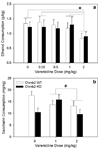Modulation of ethanol consumption by genetic and pharmacological manipulation of nicotinic acetylcholine receptors in mice
- PMID: 20072781
- PMCID: PMC2901400
- DOI: 10.1007/s00213-009-1759-1
Modulation of ethanol consumption by genetic and pharmacological manipulation of nicotinic acetylcholine receptors in mice
Abstract
Rationale: Alcohol and nicotine are commonly co-abused. Genetic correlations between responses to these drugs have been reported, providing evidence that common genes underlie the response to alcohol and nicotine. Nicotinic acetylcholine receptors (nAChRs) in the mesolimbic dopamine system are important in mediating nicotine response, and several studies suggest that alcohol may also interact with these nAChRs.
Objective: The aim of this study was to examine the role of nAChRs containing α7 or β2 subunits in ethanol consumption.
Methods: A two-bottle choice paradigm was used to determine ethanol consumption in wild-type and nAChR subunit knockout mice. Challenge studies were performed using the α4β2 nAChR partial agonist varenicline.
Results: Mice lacking the β2 subunit consumed a similar amount of ethanol compared to their wild-type siblings in an ethanol-drinking paradigm. In contrast, mice lacking the α7 nAChR receptor subunit consumed significantly less ethanol than wild-type mice but consumed comparable amounts of water, saccharin, and quinine. In C57BL/6J mice, varenicline dose-dependently decreased ethanol consumption with a significant effect of 2 mg/kg, without affecting water or saccharin consumption. This effect of varenicline was not reversed in mice lacking either the α7 or β2 subunit, providing evidence that nAChRs containing one of these subunits are not required for this effect of varenicline.
Conclusions: This study provides evidence that α7 nAChRs are involved in ethanol consumption and supports the idea that pharmacological manipulation of nAChRs reduces ethanol intake. Additional nAChRs may also be involved in ethanol intake, and there may be functional redundancy in the nicotinic control of alcohol drinking.
Conflict of interest statement
Figures






Similar articles
-
Activation of alpha4* nAChRs is necessary and sufficient for varenicline-induced reduction of alcohol consumption.J Neurosci. 2010 Jul 28;30(30):10169-76. doi: 10.1523/JNEUROSCI.2601-10.2010. J Neurosci. 2010. PMID: 20668200 Free PMC article.
-
Nicotinic acetylcholine receptors containing the α4 subunit are critical for the nicotine-induced reduction of acute voluntary ethanol consumption.Channels (Austin). 2011 Mar-Apr;5(2):124-7. doi: 10.4161/chan.5.2.14409. Epub 2011 Mar 1. Channels (Austin). 2011. PMID: 21239887 Free PMC article.
-
Varenicline blocks β2*-nAChR-mediated response and activates β4*-nAChR-mediated responses in mice in vivo.Nicotine Tob Res. 2012 Jun;14(6):711-9. doi: 10.1093/ntr/ntr284. Epub 2012 Jan 12. Nicotine Tob Res. 2012. PMID: 22241831 Free PMC article.
-
The nicotinic acetylcholine receptor partial agonist varenicline and the treatment of drug dependence: a review.Eur Neuropsychopharmacol. 2010 Feb;20(2):69-79. doi: 10.1016/j.euroneuro.2009.11.001. Epub 2009 Dec 3. Eur Neuropsychopharmacol. 2010. PMID: 19959340 Review.
-
The contribution of agonist and antagonist activities of α4β2* nAChR ligands to smoking cessation efficacy: a quantitative analysis of literature data.Psychopharmacology (Berl). 2018 Sep;235(9):2479-2505. doi: 10.1007/s00213-018-4921-9. Epub 2018 Jul 7. Psychopharmacology (Berl). 2018. PMID: 29980822 Review.
Cited by
-
The role of nicotinic acetylcholine receptors in alcohol-related behaviors.Brain Res Bull. 2020 Oct;163:135-142. doi: 10.1016/j.brainresbull.2020.07.017. Epub 2020 Jul 22. Brain Res Bull. 2020. PMID: 32707263 Free PMC article. Review.
-
The α5 neuronal nicotinic acetylcholine receptor subunit plays an important role in the sedative effects of ethanol but does not modulate consumption in mice.Alcohol Clin Exp Res. 2013 Apr;37(4):655-62. doi: 10.1111/acer.12009. Epub 2012 Nov 16. Alcohol Clin Exp Res. 2013. PMID: 23164049 Free PMC article.
-
Repeated exposure of the posterior ventral tegmental area to nicotine increases the sensitivity of local dopamine neurons to the stimulating effects of ethanol.Alcohol. 2012 May;46(3):217-23. doi: 10.1016/j.alcohol.2011.11.007. Epub 2012 Mar 25. Alcohol. 2012. PMID: 22449786 Free PMC article.
-
Nicotinic receptor modulation to treat alcohol and drug dependence.Front Neurosci. 2015 Jan 15;8:426. doi: 10.3389/fnins.2014.00426. eCollection 2014. Front Neurosci. 2015. PMID: 25642160 Free PMC article. Review.
-
Genes and Alcohol Consumption: Studies with Mutant Mice.Int Rev Neurobiol. 2016;126:293-355. doi: 10.1016/bs.irn.2016.02.014. Int Rev Neurobiol. 2016. PMID: 27055617 Free PMC article. Review.
References
-
- Bergstrom HC, Palmer AA, Wood RD, Burkhart-Kasch S, McKinnon CS, Phillips TJ. Reverse selection for differential response to the locomotor stimulant effects of ethanol provides evidence for pleiotropic genetic influence on locomotor response to other drugs of abuse. Alcohol Clin Exp Res. 2003;27(10):1535–1547. - PubMed
-
- Blomqvist O, Ericson M, Johnson DH, Engel JA, Soderpalm B. Voluntary ethanol intake in the rat: effects of nicotinic acetylcholine receptor blockade or subchronic nicotine treatment. Eur J Pharmacol. 1996;314(3):257–267. - PubMed
-
- Bowers BJ, McClure-Begley TD, Keller JJ, Paylor R, Collins AC, Wehner JM. Deletion of the alpha7 nicotinic receptor subunit gene results in increased sensitivity to several behavioral effects produced by alcohol. Alcohol Clin Exp Res. 2005;29(3):295–302. - PubMed
-
- Butt CM, King NM, Stitzel JA, Collins AC. Interaction of the nicotinic cholinergic system with ethanol withdrawal. J Pharmacol Exp Ther. 2004;308(2):591–599. - PubMed
-
- Cahill K, Stead LF, Lancaster T. Nicotine receptor partial agonists for smoking cessation. Cochrane Database Syst Rev. 2008;(3) CD006103. - PubMed
Publication types
MeSH terms
Substances
Grants and funding
LinkOut - more resources
Full Text Sources
Medical

